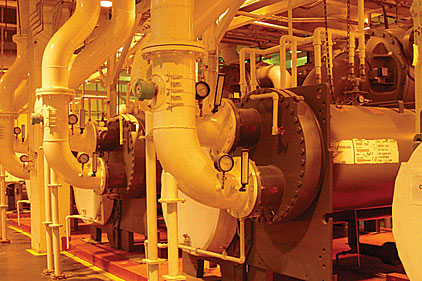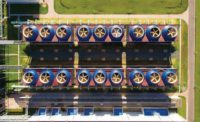UMass Memorial Health Care (UMMHC) is the largest health care system in Central and Western Massachusetts, and the clinical partner of the University of Massachusetts Medical School. The health system includes UMass Memorial Medical Center and four community hospitals: Clinton Hospital, HealthAlliance Hospital, Marlborough Hospital, and Wing Memorial Hospital. UMass is the only Level 1 Trauma Center for adults and children in Central Massachusetts and the region’s only Level III NICU. The health system includes home health and hospice programs, behavioral health programs, community-based physician practices, MRI centers, an acute rehabilitation hospital, and an international bone marrow registry.
Historically, UMMHC has progressively grown both in health care services and the real estate needed to support its medical service needs. Engineered Systems featured UMMHC’s ophthalmology project and the HVAC challenges associated with this project back in the July 2010 issue with an article titled, “Health Care Renovations: a Chilling Process.” At the start of the design phase, I received a call from Gary Valcourt, senior director of capital planning and management for Umass Memorial Medical Center, who was seeking our third-party opinion as to the direction of the air conditioning primary cooling design for this LEED® interior renovation.
Valcourt had a “gut feeling,” based on his years of experience, that Hahnemann Hospital did not need to add more air conditioning capacity as the solution to the air conditioning demands of this project. Valcourt said that a central chilled water plant and system distribution study would be authorized to review and possible challenge the wisdom of adding as much as 120 tons of direct expansion (DX) cooling to the facility. The existing central system assessment team consisted of Massachusetts-based RDK Engineers consulting engineers and Thomas-Young & Associates (TY&A), a Massachusetts air and water balancing firm. Together, they surveyed the existing conditions and determined that there should be sufficient chilled water capacity but that changes had to be made to bring this capacity out and avoid adding 120 tons of DX cooling.
Tom Shomphe, project manager from the UMMHC Planning & Construction group, was assigned to the job to represent Hahnemann Hospital on this troubleshooting study and report. Shomphe would follow through on the project which would become a series of corrective measures jobs to fine-tune the central chiller plant as well as change out antiquated mechanical equipment.
|
HOUSTON, WE HAVE A PROBLEM
The report clearly identified the potential to accommodate the ophthalmology project’s need for chilled water while identifying existing conditions that compromised the overall performance of the combined, cross-connected chiller plants. The overall deficiency was that the hospital needed all three chillers to be online during peak air-conditioning periods of the summer.
This knowledge of the current operating conditions led to the determination that the long-term benefits to fulfill the recommended measures would include a more energy-efficient, single central system that would also achieve the initial concern (squeezing out sufficient cooling capacity without adding more energy consuming equipment). Going forward, planning and construction and O&M groups would work with this writer through a series of project improvement steps that would be managed by Shomphe, with operation input from Dave Berthiaume.
Step 1 was to correct the two AHU cooling coils that had been installed incorrectly years earlier. In addition, the crossover valving strategy was established so that cold chilled water supply (CHWS) went to each of the eight central air systems, along with CHWS to several fancoil units. The benefits were primarily correcting system and equipment installations deficiencies that would inherently improve system performance but would not save any energy. The operating performance was an immediate success, with improved cooling capabilities from the two previously deficient units. In turn, this improved space comfort for those occupants being served via these AHUs.
Step 2 was to replace the antiquated blow-through cooling tower that served the 245-ton electric chiller. It was determined that by changing to a draw-through tower, the electrical cooling tower fan hp could be reduced from 75 hp to 30 hp along with the addition of a VSD. The benefits were twofold. First, there was electrical installation savings of 45 hp and improved performance. Secondly, full heat rejection from the electric chiller’s condenser heat allows this chiller to operate up to its rated peak of 245 tons vs. an unknown, de-rated chiller capacity due to the deteriorated blow-through cooling tower. The step was an immediate success, as more chilled water capacity became available, although the result was not sufficient to clearly achieve the anticipated long-range surplus capacity goal.
Step 3 was to repeat the cooling tower replacement process, but this time replacing two draw-through cooling towers, each with a 25-hp motor, with new equivalent sized tower fans (but with VSD fan motors). In addition, a waterside economizer system was incorporated into the condenser water chilled water system to enhance performance and to reduce the mechanical cooling hour energy consumption during the off-season months. The benefits were similar to the first tower replacement that included full heat rejection from the two SAM units, allowing them to deliver improved cooling capacity but not up to the originally rated 540 combined tons of chilled water cooling vs. a previously unknown chiller capacity output. The plate-and-frame waterside economizer provided free cooling in place of keeping a chiller ready to go for light air conditioning loads in the heating season.
Also provided under this contract was the removal of all remaining three-way valves replacing them with straight-through ATC chilled water valves and the addition of DDCs on all new equipment. The operating performance was another immediate success, but in addition, the full capacity of all three chillers online now provided the hospital with the additional capacity for the ophthalmology project while establishing surplus cooling capacity. Facilities personnel were now able to use two of the three chillers during much of the A/C season, which required the third chiller to be turned on for peak design day demands. In addition, the operations group would maximize the run-time for the waterside economizer before turning on a chiller and consuming additional energy either gas or electricity.
Step 4 was to replace the two antiquated 1960s steam absorption units with new SAM equipment that came with DDC and the addition of VSDs on the chilled water and condenser water pumps to minimize pumping requirements based on one, two, or three chillers online. The hospital also accepted a design-build proposal to expand this new DDC system and integrate it, via the Internet, to UMMHC’s hospital system-wide chilled water management going back to the main off-site computer. The benefits were that SAM cooling capabilities were maximized over the past status quo, where the old units had plugs/damaged chiller bundle tubes. The previous de-rated SAMs were now replaced with sufficient cooling capacity to the point that the electric chiller was not required and became a standby chiller during the summer of 2012. This reduced the hospital’s electrical kWh consumption and eliminated the approximate 160-kW demand charge the hospital was billed monthly. The BACnet-based Internet interface also provided improved energy management (and off-site quick response, should operations need to access the chiller plant as their first-response initiative). The addition of VSDs also enhances the energy management capabilities of the central system.
LESSONS LEARNED
With the combined experience of the planning and construction and O&M staff, the hospital was able to achieve optimum chilled water capacity from its existing central cooling plant by methodically removing antiquated equipment long overdue for replacement, while systematically reassessing the chilled water system piping distribution. This eliminated inherent performance problems with the two-chiller plant operation and problems that had evolved over years of focusing on building renovations without stepping back and spot-checking the overall impact of each job’s effects on the hospital’s ability to cost-effectively support the space comfort of its occupants. Specifically, the planning and construction group questioned the design intent of the ophthalmology project as it pertained to the central chiller plant capacity.
While routinely benchmarking actual performance to historical data and operational rule-of-thumb data, UMMHC took the route not often traveled by simultaneously assessing a 14,000-sq-ft renovation in sync with “how are we doing” by providing energy-efficient cooling. As a rule, each capital project stands on its own.
At the same time, the hospital funded a system capacity impact study to ensure the renovation project first-cost decisions are truly, in this case, the lowest first cost for the work can be considered the exception to the rule. It could be said that UMMHC broke tradition and clearly repeated the benefits from this approach.
The short-term and long-term benefits that started with Gary Valcourt questioning the original building square feet per ton vs. rule-of-thumb are as follows:
The ophthalmology renovation proceeded forward without the addition of 120-ton air cooled DX unit.
Two AHUs, incorrectly piped years ago, were re-piped and the associated systems improved with lower discharge air temperatures.
The cross-connected twin chiller plant piping configuration was corrected to improve system performance with the same chilled water supply temperature to each of the system’s cooling coils.
•Antiquated and inefficient cooling towers and steam absorption units were replaced with new, more efficient equipment.
•A waterside chilled water system economizer installation was provided to deliver spring, winter, and fall cooling while also reducing the run-time of the chillers thus extending equipment service life.
•Reassignment of the originally “base-loaded” electric chiller to its role as the standby chiller, thus eliminating any electrical demand to the hospital’s peak electrical usage.
•Transition from an original 785 tons (three chillers operating) cooling online to less than 540 tons (two chillers operating) on-line at any time during the A/C season.
•Better system documentation was developed through the four-step improvement process, providing the O&M staff a better understanding of the entire central chilled water system and allowing them to further improve performance based on historical data being trended on the DCC central plant management computer.
•Off-site access to the central chiller plant became available so the hospital can monitor, measure, troubleshoot, and quickly respond to any hospital user inquires.
In light of these lessons, consideration is now being given to further reduction in energy and carbon-footprint based on updated knowledge and system capabilities. ES



